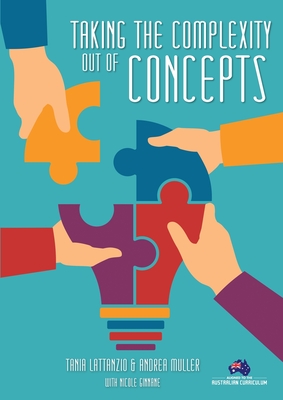
Ãngel, J. Rafael
product information
description
sed Curriculum and Instruction (CBCI) model in the area of additional languages needed examples to support its theory and practice, and to empower its implementation. This book ends the myth of what is and what is not possible, and provides a solution for that need. In addition to grounding and focusing the CBCI model in additional language teaching, this work includes examples of planners, learning routines, and carefully follows the steps of formative and summative evaluation of learning and evaluation experiences, hence its name: From Inception to Fruition. Likewise, the variety of resources that come with it makes it a difficult resource to compare. This work was produced to support additional language teachers who wish to incorporate Concept-Based pedagogy, as well as nuance their practice with various models of inquiry and explicit skill development. 5 years of research, collaboration with the pioneers of the CBCI model, and the development of pilot planners and lessons in different international schools endorse this book, the first of its kind in the area of additional languages.
The implementation of the Concept-Based Curriculum and Instruction (CBCI) model in the area of additional languages needed examples to support its theory and practice, and to empower its implementation. This book ends the myth of what is and what is not possible, and provides a solution for that need. In addition to grounding and focusing the CBCI model in additional language teaching, this work includes examples of planners, learning routines, and carefully follows the steps of formative and summative evaluation of learning and evaluation experiences, hence its name: From Inception to Fruition. Likewise, the variety of resources that come with it makes it a difficult resource to compare. This work was produced to support additional language teachers who wish to incorporate Concept-Based pedagogy, as well as nuance their practice with various models of inquiry and explicit skill development. 5 years of research, collaboration with the pioneers of the CBCI model, and the development of pilot planners and lessons in different international schools endorse this book, the first of its kind in the area of additional languages. With a multitude of scenarios that illustrate the teaching-learning process of a unit of inquiry that follows the principles of Concept-Based language teaching, this book becomes an important tool for secondary or high school language teachers. The author not only invites us to reflect on the creation of a contextualised curriculum in areas of interest for young people that attends to the relevance of the issues of their world and not of the world of adults, but also invites us to recognise the value of our subject.
Dr. Glauce Serralvo J. Rafael Ángel's protocol for curriculum design and mapping helped to upgrade our language acquisition curriculum and to develop a strategy to support, administrate and evaluate my team's learning and teaching practices. This protocol is very helpful and comprehensive and allows everyone not only to understand relationships, but also to become aware of natural and meaningful progression with an authentic focus on the learners. The final document is an outcome that truly maps, guides, and helps in the implementation of a sustainable curriculum.
Ms. Boudour Obeid Working with the CBCI language planner greatly helped my Dutch language team to keep focus throughout the planning process. We moved from learning about a topic towards inquiring into more specific language patterns and more specific language skills! The 'transfer from' and 'transfer to' helped us to see the bigger picture. I'm already looking forward to planning the next unit as a CBCI unit!
Annefieke Bonants
The implementation of the Concept-Based Curriculum and Instruction (CBCI) model in the area of additional languages needed examples to support its theory and practice, and to empower its implementation. This book ends the myth of what is and what is not possible, and provides a solution for that need. In addition to grounding and focusing the CBCI model in additional language teaching, this work includes examples of planners, learning routines, and carefully follows the steps of formative and summative evaluation of learning and evaluation experiences, hence its name: From Inception to Fruition. Likewise, the variety of resources that come with it makes it a difficult resource to compare. This work was produced to support additional language teachers who wish to incorporate Concept-Based pedagogy, as well as nuance their practice with various models of inquiry and explicit skill development. 5 years of research, collaboration with the pioneers of the CBCI model, and the development of pilot planners and lessons in different international schools endorse this book, the first of its kind in the area of additional languages. With a multitude of scenarios that illustrate the teaching-learning process of a unit of inquiry that follows the principles of Concept-Based language teaching, this book becomes an important tool for secondary or high school language teachers. The author not only invites us to reflect on the creation of a contextualised curriculum in areas of interest for young people that attends to the relevance of the issues of their world and not of the world of adults, but also invites us to recognise the value of our subject.
Dr. Glauce Serralvo J. Rafael Ángel's protocol for curriculum design and mapping helped to upgrade our language acquisition curriculum and to develop a strategy to support, administrate and evaluate my team's learning and teaching practices. This protocol is very helpful and comprehensive and allows everyone not only to understand relationships, but also to become aware of natural and meaningful progression with an authentic focus on the learners. The final document is an outcome that truly maps, guides, and helps in the implementation of a sustainable curriculum.
Ms. Boudour Obeid Working with the CBCI language planner greatly helped my Dutch language team to keep focus throughout the planning process. We moved from learning about a topic towards inquiring into more specific language patterns and more specific language skills! The 'transfer from' and 'transfer to' helped us to see the bigger picture. I'm already looking forward to planning the next unit as a CBCI unit!
Annefieke Bonants
member goods
No member items were found under this heading.
notems store
Return Policy
All sales are final
Shipping
No special shipping considerations available.
Shipping fees determined at checkout.







